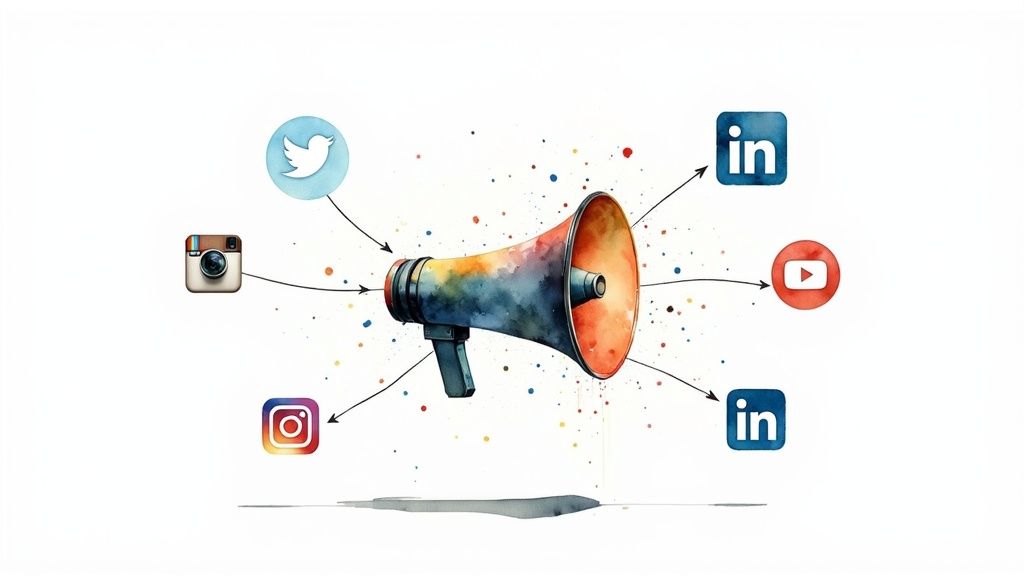Creating exceptional content is only half the battle; the real challenge lies in getting it in front of the right audience. In a landscape saturated with information, even the most brilliant articles, videos, or podcasts can fail to make an impact without a robust promotion plan. Simply hitting 'publish' and hoping for the best is a strategy destined for obscurity. The key to breaking through the noise and achieving a significant return on your investment is to employ a diverse and powerful set of content promotion strategies.
This guide moves beyond generic advice to provide a detailed roadmap of nine actionable strategies designed to amplify your reach, engage your target audience, and drive meaningful results. We will explore everything from leveraging social platforms and building communities to optimizing for search engines and repurposing content for maximum impact. To truly unlock your content's potential, mastering various promotional techniques is essential. For instance, you can explore proven podcast promotion strategies that apply broadly to many content types, offering a specialized look at a single, powerful format.
Our goal is to arm you with a comprehensive toolkit that ensures your hard work translates into tangible growth. By implementing the tactics outlined here, you will learn how to:
- Systematically distribute your content across multiple channels.
- Engage with targeted communities and industry influencers.
- Maximize visibility through both organic search and paid advertising.
By the end of this article, you will be equipped to build a dynamic promotion engine that consistently delivers your message to the people who need to hear it most, transforming your content from a published asset into a powerful growth driver for your business.
1. Social Media Cross-Platform Promotion
Social media cross-platform promotion is one of the most effective content promotion strategies for maximizing reach in the digital age. This approach involves more than just sharing the same link across all your profiles. It means strategically adapting your core content to fit the unique format, audience, and algorithm of each social media platform. By tailoring your message, you can amplify its visibility, drive targeted traffic, and engage different segments of your audience where they are most active.
This strategy’s power lies in its ability to repurpose a single piece of content into multiple assets. For example, a comprehensive blog post can be transformed into a professional infographic for Pinterest, a quick tips carousel for Instagram, a thought-provoking thread for Twitter, and an in-depth discussion starter for LinkedIn. This maximizes the return on your initial content creation investment.

Why This Strategy Is Effective
Cross-platform promotion allows you to meet your audience on their preferred channels with content that feels native to the platform. A user scrolling through TikTok expects short-form video, while a LinkedIn user is more receptive to professional insights and data. By respecting these contextual differences, your promotion feels less like an advertisement and more like valuable, native content. This builds brand authority and fosters genuine connections. As you develop your approach, it's crucial to focus on interaction. Learning effective strategies to increase social media engagement is vital for reaching a wider audience through shares, comments, and algorithm boosts.
How to Implement Cross-Platform Promotion
- Adapt, Don't Just Syndicate: Instead of just copying and pasting, reformat your content. Turn key statistics from a case study into a visually appealing Instagram Story or a Twitter poll.
- Optimize for Each Platform: Use platform-specific features like Instagram Reels, TikTok sounds, LinkedIn articles, and relevant hashtags to increase discoverability.
- Schedule for Peak Times: Post when your audience is most active on each specific platform. Tools like Buffer or Hootsuite can help you analyze and schedule this effectively.
- Cross-Link Intelligently: Guide your followers between platforms. For instance, mention in an Instagram Story, "For the full data behind this, check out our new post on LinkedIn," and provide a direct link.
2. Email Newsletter Content Syndication
Email newsletter content syndication is a powerful direct-to-audience content promotion strategy. This method involves leveraging your email list to deliver summaries, teasers, or full versions of your latest content directly to your subscribers' inboxes. Instead of waiting for audiences to find your content, you proactively push it to a group of people who have already opted in, making it a highly effective way to drive consistent, high-intent traffic back to your website or blog.
The core value of this strategy lies in its ability to build and nurture a direct relationship with your audience. Unlike algorithm-dependent platforms, email provides an owned channel of communication. Companies like Morning Brew and TheSkimm built media empires primarily on this model, demonstrating its power to create habitual readership and foster deep loyalty by consistently delivering value.

Why This Strategy Is Effective
Email newsletters cut through the digital noise and land directly in a user’s personal space. This creates an opportunity for deep engagement that social media often cannot match. Because subscribers have explicitly given you permission to contact them, they are significantly more receptive to your message. This leads to higher click-through rates and more meaningful traffic compared to passive channels. Furthermore, it allows you to control the narrative and user experience completely, from the subject line to the final call-to-action, without interference from platform algorithms.
How to Implement Email Newsletter Content Syndication
- Segment Your Audience: Don't send every piece of content to everyone. Segment your list based on interests, past behavior, or demographic data to deliver highly relevant promotions that resonate.
- Craft Compelling Snippets and Subject Lines: Your subject line is the gatekeeper. Make it intriguing and benefit-driven. In the email body, provide a compelling summary or hook that makes clicking through to the full article irresistible.
- Include Clear Calls-to-Action (CTAs): Use prominent buttons or links like "Read the Full Post," "Get the Guide," or "Watch the Video." Make it obvious what you want the reader to do next.
- Optimize for Mobile: A majority of emails are opened on mobile devices. Ensure your newsletter template is responsive and easy to read on a small screen to avoid losing engagement.
3. Influencer and Guest Collaboration
Influencer and guest collaboration is one of the most powerful partnership-based content promotion strategies available. This method involves partnering with industry experts, influencers, or other creators to co-create or cross-promote content. By leveraging another creator's established audience and credibility, you can introduce your brand to a new, highly relevant group of potential followers and customers. It’s a symbiotic relationship where both parties gain exposure and authority.
This strategy's value comes from the authentic endorsement it provides. When a trusted voice in your niche, like Tim Ferriss featuring an expert on his podcast or Brian Dean guest posting on a major marketing blog, shares your content or perspective, it serves as a powerful social proof signal. This taps into the inherent trust between the influencer and their audience, bypassing the skepticism often associated with traditional advertising.

Why This Strategy Is Effective
Collaborations effectively "borrow" trust and reach. Instead of spending months or years building an audience from scratch, you can gain immediate access to one that is already engaged and interested in your topic. This approach is highly effective because it feels organic and value-driven. A podcast guest appearance or a collaborative webinar is perceived as valuable content, not a direct sales pitch. This authenticity builds brand affinity and can drive significant referral traffic and lead generation, accelerating your growth far faster than solo efforts.
How to Implement Influencer and Guest Collaboration
- Target Relevant Partners: Research and identify influencers or experts whose audience aligns perfectly with your target demographic. Focus on relevance over sheer follower count.
- Offer Value First: Approach potential collaborators with a clear value proposition for them and their audience. This could be unique data, a free tool, or a well-researched guest post topic that saves them time.
- Create Joint Content: Go beyond simple shoutouts. Co-create a comprehensive guide, host a joint webinar, or appear as a guest on their podcast to provide deep, actionable insights.
- Establish Clear Expectations: Create a simple agreement outlining deliverables, promotional responsibilities for both parties, and timelines to ensure a smooth and mutually beneficial partnership.
- Track and Nurture: Use tracking links to measure referral traffic and engagement from the collaboration. Maintain the relationship beyond a single project for potential future opportunities.
4. Search Engine Optimization (SEO) Content Strategy
Search Engine Optimization (SEO) is one of the most sustainable and powerful content promotion strategies for achieving long-term growth. Rather than a short-term promotional burst, SEO focuses on optimizing your content to rank high in search engine results, creating a continuous stream of organic, targeted traffic. This involves detailed keyword research, on-page optimization, and creating content that directly answers the questions your audience is asking. By aligning your content with search intent, you position your brand as the definitive answer when potential customers are actively seeking solutions.
This strategy transforms your content from a temporary campaign asset into a permanent, traffic-generating machine. For instance, brands like HubSpot and Ahrefs have built their entire customer acquisition models around comprehensive SEO-driven content, turning their blogs into industry-leading resources that attract millions of qualified visitors each month. This approach ensures your promotional efforts deliver compounding returns over time.

Why This Strategy Is Effective
SEO's effectiveness comes from its ability to capture high-intent audiences at the exact moment they are looking for information. Unlike interruptive advertising, organic search traffic consists of users who are proactively seeking answers, products, or services. Ranking for relevant terms establishes your brand as a credible authority, building trust before a user even lands on your site. Mastering effective SEO strategies is a cornerstone of digital marketing, as it ensures your valuable content is discoverable for months and even years after publication, generating leads and sales with minimal ongoing effort.
How to Implement Search Engine Optimization (SEO) Content Strategy
- Prioritize Keyword Research and Search Intent: Before writing, use tools like Ahrefs or Semrush to find what your audience is searching for. Focus on understanding their goal (the "why" behind the query), not just the keywords they use.
- Execute On-Page Optimization: Ensure every piece of content has an optimized title tag, meta description, URL, and image alt text. Structure your content with clear headings (H1, H2, H3) to improve readability for both users and search engines.
- Build High-Quality Backlinks: Promote your best content to relevant websites, journalists, and bloggers in your industry to earn authoritative backlinks, which are a critical ranking factor.
- Ensure Technical Health: Your website must be mobile-friendly and load quickly. Use Google's PageSpeed Insights to identify and fix technical issues that could hinder your rankings.
- Monitor and Refresh Content: Regularly review your content's performance using Google Analytics and Search Console. Update older posts with new information to keep them relevant and maintain their rankings.
5. Paid Social Media Advertising
While organic reach is valuable, paid social media advertising is one of the most powerful and scalable content promotion strategies available today. This approach involves using the sophisticated advertising tools offered by platforms like Facebook, Instagram, LinkedIn, and Twitter to push your content in front of highly specific, targeted audiences. Instead of waiting for users to discover your content, you pay to place it directly in their feeds, ensuring it reaches people most likely to be interested based on demographics, interests, and online behaviors.
The core advantage of this strategy is its precision and control. You can amplify your best-performing content, drive traffic to a landing page, or generate leads with unparalleled accuracy. For instance, a B2B company can use LinkedIn sponsored content to promote a white paper directly to C-level executives in the tech industry, while a D2C brand can use Instagram Story ads to showcase a new product to users who have previously engaged with similar brands. This targeted investment significantly boosts the ROI of your content creation efforts.
Why This Strategy Is Effective
Paid social advertising cuts through the noise of crowded organic feeds and bypasses declining organic reach. It allows you to guarantee visibility with a demographic that you define, making it exceptionally efficient for achieving specific business goals like lead generation or sales. By using features like retargeting, you can re-engage users who have already visited your website, serving them relevant content that nudges them further down the conversion funnel. This makes paid social a crucial component for any comprehensive content promotion plan, transforming content from a brand-building asset into a direct revenue driver.
How to Implement Paid Social Media Advertising
- Start Small and Test: Allocate a modest budget initially to test different ad creatives, copy, and audience segments. Identify what works best before scaling your investment.
- Use Compelling Visuals: Your ad's visual element is the first thing users see. Use high-quality images or videos and a clear, concise call-to-action (CTA) to capture attention and drive clicks.
- Leverage Retargeting: Install the Facebook Pixel or LinkedIn Insight Tag on your website. Create custom audiences to retarget visitors who have viewed specific content, like a blog post or product page.
- Monitor Ad Frequency: Keep a close eye on your ad frequency metric. If people see the same ad too many times, it can lead to ad fatigue and diminished results. Rotate your creatives to keep your campaign fresh.
6. Community and Forum Engagement
Community and forum engagement is one of the most authentic content promotion strategies available, focusing on building relationships rather than direct advertising. This approach involves actively participating in online communities where your target audience gathers, such as Reddit, Quora, Facebook Groups, and niche-specific forums. By consistently providing value, answering questions, and sharing insights, you establish yourself as a credible expert, allowing you to promote your content naturally within the context of helpful conversations.
The strategy's success comes from its non-promotional nature. Instead of broadcasting a message, you become part of the community’s fabric. For example, Buffer famously gained its first users by having its founders actively participate in discussions on platforms like Hacker News and Inbound.org, offering genuine advice on social media and startups. This value-first approach builds trust, making the community more receptive when you eventually share a relevant link to your content.
Why This Strategy Is Effective
This method works because it taps into pre-existing, highly engaged audiences actively seeking solutions and information. Unlike traditional advertising that interrupts, this strategy integrates your brand into the user's journey of discovery. By respecting community rules and focusing on helping others, you earn social currency and credibility. This makes your content recommendations feel like a helpful tip from a trusted peer, not a sales pitch, leading to higher-quality traffic and more dedicated followers.
How to Implement Community and Forum Engagement
- Provide Value First, Promote Second: Dedicate 80% of your time to answering questions, upvoting helpful content, and participating in discussions without mentioning your brand. Only share your content when it directly and thoroughly answers a user's question.
- Adhere Strictly to Community Guidelines: Each community (especially subreddits) has its own rules about self-promotion. Read and respect them to avoid being banned. Building a positive reputation with moderators is key.
- Engage Consistently: Don't just show up when you have something to promote. Consistent, daily or weekly participation makes you a recognizable and trusted member of the community.
- Identify Relevant Conversations: Use platform search functions or tools like Mention to find discussions related to your content. Look for questions you can answer with your expertise and, eventually, your blog posts or guides.
7. Content Repurposing and Multi-Format Distribution
Content repurposing is an efficiency-focused strategy that transforms a single piece of content into multiple formats to extend its reach and lifespan. Instead of constantly creating from scratch, this approach involves systematically deconstructing a core asset, like a webinar or in-depth blog post, and reformatting its key ideas for different platforms and audience preferences. This is one of the most powerful content promotion strategies for maximizing your creative investment.
The core principle is to work smarter, not harder. A comprehensive piece of content contains dozens of smaller, valuable insights. By extracting and repackaging them, you can appeal to audiences who prefer video, audio, text, or visuals without diluting your message. For instance, Gary Vaynerchuk famously documents his keynotes and then breaks them down into podcasts, blog articles, quote graphics, and short video clips, distributing them across every relevant social channel.
Why This Strategy Is Effective
This method dramatically increases the ROI of your initial content creation effort. It allows you to meet diverse audience segments where they are most comfortable consuming information. Someone who doesn't have time for a 3,000-word article might watch a two-minute video summary on TikTok or listen to a 20-minute podcast segment during their commute. Repurposing ensures your core message penetrates different parts of the market, reinforcing brand authority and keeping your content calendar full with high-quality material.
How to Implement Content Repurposing
- Start with a “Pillar” Piece: Identify your most comprehensive and valuable content, such as a research report, a webinar, or a cornerstone blog post, as the source material.
- Create a Repurposing Workflow: Map out potential formats for your pillar content. For example, a blog post can become a Twitter thread, an Instagram carousel, a short video script, and a section in an email newsletter.
- Adapt, Don't Just Copy: Tailor the tone and style for each new format. A professional LinkedIn article will have a different voice than a casual, engaging Instagram Reel, even if they cover the same topic.
- Track Format Performance: Use analytics to identify which repurposed formats generate the most engagement. This data helps you refine your content promotion and focus on what resonates most with your audience.
8. Public Relations and Media Outreach
Public Relations and Media Outreach is a powerful, credibility-focused approach among content promotion strategies. It involves proactively engaging with journalists, influential bloggers, podcasters, and media outlets to secure authentic coverage for your content, brand, or expertise. Instead of paying for placement, this strategy relies on building relationships and presenting newsworthy stories that earn media mentions, features, and backlinks.
The core of this strategy is transforming your content into a compelling news angle. For instance, an original research report can become a data-backed story pitch for an industry publication, or a unique case study can be offered as an exclusive to a prominent business journalist. This earned media acts as a powerful third-party endorsement, lending your content a level of authority and trustworthiness that paid advertising cannot replicate.
Why This Strategy Is Effective
Media outreach leverages the established credibility and reach of media outlets to amplify your message. A single feature in a respected publication can drive significant referral traffic, boost brand recognition, and dramatically improve your SEO through high-authority backlinks. Unlike fleeting social media posts, earned media coverage often has a long shelf life, continuing to drive results for months or even years. This strategy positions your brand not just as a business, but as a thought leader and a valuable source of information within your industry.
How to Implement Public Relations and Media Outreach
- Identify Relevant Contacts: Research and build a targeted media list of journalists, editors, and bloggers who actively cover your niche. Use tools like Cision or Muck Rack, or simply search relevant publications.
- Craft a Newsworthy Pitch: Your content is not the story; the insights or data within it are. Frame your pitch around a compelling angle that is timely, relevant, and offers value to the journalist’s audience.
- Develop a Media Kit: Prepare a professional media kit that includes your company background, high-resolution logos, executive headshots, and key press releases. Make it easy for journalists to find what they need.
- Build Relationships Before You Pitch: Connect with media professionals on platforms like LinkedIn or Twitter long before you need coverage. Share their work and engage with their content to build genuine rapport.
- Follow Up Strategically: Send one polite follow-up email a few days after your initial pitch. Avoid being pushy, as this can damage your relationship and future opportunities.
9. Strategic Timing and Trending Topic Leverage
Strategic timing and trending topic leverage is a powerful opportunistic approach within the broader scope of content promotion strategies. This method involves aligning your content release and promotion with optimal timing, seasonal trends, breaking news, or viral topics to capture audience attention when it is most heightened. Instead of pushing content into a void, you are inserting it directly into an ongoing, high-volume public conversation, dramatically increasing its potential for visibility and engagement.
This strategy’s effectiveness comes from its ability to make a brand feel relevant, agile, and culturally aware. When executed well, it can generate massive organic reach in a short period. A prime example is Oreo's legendary "You can still dunk in the dark" tweet during the 2013 Super Bowl power outage. This real-time response was perfectly timed, witty, and on-brand, transforming a moment of national focus into a monumental marketing win that is still discussed today.
Why This Strategy Is Effective
This tactic capitalizes on existing audience interest and search volume. When a topic is trending, people are actively seeking information and commentary related to it. By providing valuable or entertaining content at that exact moment, your promotion feels less like an interruption and more like a welcome contribution to the dialogue. This builds brand personality and positions you as a timely, in-the-know resource, which can foster significant goodwill and brand recall. The key is to add to the conversation, not just hijack it for a sales pitch.
How to Implement Strategic Timing and Trending Topic Leverage
- Set Up Listening Posts: Use tools like Google Alerts, BuzzSumo, or social media listening software (e.g., Brandwatch) to monitor keywords related to your industry, brand, and target audience. This allows you to spot emerging trends early.
- Create a Rapid Response Plan: Agility is crucial. Establish a small, empowered team that can quickly create and approve content. Develop simple templates for graphics, videos, or blog posts to expedite the creation process when a relevant event occurs.
- Maintain Brand Authenticity: Only jump on trends that align with your brand's voice and values. A forced or irrelevant connection can backfire and make your brand seem opportunistic in a negative way.
- Balance with Evergreen Content: While capitalizing on trends is powerful, it should complement your core content strategy, not replace it. Use trending topics to attract a new audience and then guide them toward your foundational, evergreen content.
Content Promotion Strategies Comparison Matrix
| Strategy | Implementation Complexity 🔄 | Resource Requirements ⚡ | Expected Outcomes 📊 | Ideal Use Cases 💡 | Key Advantages ⭐ |
|---|---|---|---|---|---|
| Social Media Cross-Platform Promotion | Medium 🔄 (platform-specific skills) | Moderate ⚡ (content adaptation) | Increased reach & engagement 📊 | Brands targeting diverse social audiences 💡 | Cost-effective, diversified engagement, brand recognition ⭐ |
| Email Newsletter Content Syndication | Medium 🔄 (list building & segmentation) | Moderate ⚡ (email tools & content) | High conversion & ROI 📊 | Businesses with engaged subscriber base 💡 | Direct audience access, high ROI, relationship building ⭐ |
| Influencer and Guest Collaboration | High 🔄 (relationship building) | Moderate ⚡ (coordination effort) | Expanded audience & credibility 📊 | Brands seeking authority through partnerships 💡 | Access to trusted audiences, cost-effective, high engagement ⭐ |
| SEO Content Strategy | High 🔄 (technical skills & ongoing) | Moderate ⚡ (tools & content) | Sustainable organic traffic growth 📊 | Long-term traffic & brand authority building 💡 | Cost-effective over time, high-intent targeting, compounding returns ⭐ |
| Paid Social Media Advertising | Medium 🔄 (ad setup & optimization) | High ⚡ (budget & creative assets) | Immediate reach and conversions 📊 | Fast traffic and targeted campaigns 💡 | Precise targeting, scalable, measurable ROI ⭐ |
| Community and Forum Engagement | High 🔄 (consistent active participation) | Low ⚡ (time & effort) | Trust and niche targeted traffic 📊 | Niche communities, relationship-driven growth 💡 | Builds trust, cost-effective, valuable audience insights ⭐ |
| Content Repurposing & Multi-Format Distribution | Medium 🔄 (multiformat skills) | Moderate ⚡ (production resources) | Extended content lifespan & wider reach 📊 | Maximizing content ROI across audiences 💡 | Increases volume & formats, accommodates preferences ⭐ |
| Public Relations & Media Outreach | High 🔄 (relationship & pitch crafting) | Moderate ⚡ (media assets creation) | Credibility, viral exposure, backlinks 📊 | Brand authority and wide exposure via trusted outlets 💡 | Third-party validation, authority, potential viral reach ⭐ |
| Strategic Timing & Trending Topic Leverage | High 🔄 (constant monitoring & fast response) | Low ⚡ (agility & tools) | Increased engagement & viral potential 📊 | Opportunistic marketing aligned with trends 💡 | Cost-effective visibility boost, better algorithm performance ⭐ |
From Strategy to Execution: Your Next Move
You've just navigated a comprehensive blueprint of modern content promotion strategies. From the organic reach of targeted SEO and the viral potential of social media advertising to the relationship-driven power of influencer collaborations and community engagement, the pathways to amplify your message are more diverse and accessible than ever. We've explored how to syndicate content through email newsletters, repurpose a single asset into a dozen formats, and leverage the timeliness of trending topics to capture immediate attention.
The sheer volume of options can feel overwhelming. However, the goal isn't to execute all nine strategies simultaneously. That's a direct route to burnout and diluted results. Instead, the true power lies in strategic selection and masterful execution. The most successful marketers don't do everything; they do the right things exceptionally well. Your task now is to transition from learning to doing, transforming this knowledge into a tangible, results-driven action plan.
Distilling Your Core Takeaways
The central theme connecting every strategy is this: creation is only half the battle. A brilliant article, video, or podcast that no one sees has zero impact. Promotion is the essential engine that drives your content to the eyes and ears of your target audience, turning your creative investment into measurable outcomes like traffic, leads, and sales.
Think of these strategies not as a checklist, but as a flexible toolkit. * For Maximum Reach: Paid social advertising and strategic PR outreach can put your content in front of massive, previously untapped audiences almost instantly. * For Building Authority: Consistent SEO, guest collaborations, and active participation in relevant forums and communities build long-term trust and credibility. * For Efficiency and ROI: Content repurposing and email newsletter syndication are masters of leverage, allowing you to extract maximum value from every single piece of content you create.
The critical takeaway is that your promotion plan must be as thoughtfully crafted as your content plan. It requires understanding your audience's habits, defining clear objectives for each campaign, and committing to consistent effort.
Crafting Your Actionable Promotion Blueprint
So, where do you begin? The key is to start small, build momentum, and scale your efforts based on data. Don't try to launch a PR campaign, a full-scale paid ad strategy, and a content repurposing system all in the same week.
Here’s a simple framework to guide your next steps:
- Conduct a Resource Audit: Honestly assess your current resources. What is your budget? How much time can you or your team dedicate to promotion each week? What skills do you already possess (e.g., strong writing for outreach, graphic design for social media)?
- Select Your "Power Pair": Choose two strategies from the list that align with your audit. A powerful starting combination could be SEO Content Strategy (for long-term organic growth) paired with Community and Forum Engagement (for immediate feedback and relationship building). Another great pair is Content Repurposing and Social Media Cross-Platform Promotion to maximize the assets you already have.
- Define a 30-Day Goal: Set a specific, measurable goal for your chosen strategies. For example: "I will identify and actively participate in three relevant online communities, sharing our latest blog post and generating 15 qualified clicks back to our site." or "I will repurpose one pillar blog post into a 5-tweet thread, a short video script, and an infographic to be shared across all channels."
- Measure, Analyze, Iterate: At the end of 30 days, review your results. What worked? What didn't? Use these insights to refine your approach for the next month. Perhaps the forums drove more traffic than expected, signaling an opportunity to double down. Maybe the video script fell flat, indicating a need to focus on a different format. This iterative process is the core of effective content promotion strategies.
Ultimately, mastering content promotion is what separates stagnant blogs from thriving media hubs and unknown brands from industry leaders. It’s the dynamic, ongoing process that ensures your valuable insights don't just exist, but that they connect, resonate, and inspire action. You have the strategies. Now is the time to execute.
Ready to streamline your content creation and promotion efforts? The rebelgrowth platform is your all-in-one solution, using AI to help you write SEO-optimized articles, generate and schedule social media posts, and even build a backlink exchange network to supercharge your outreach. Take the guesswork out of your content promotion by visiting rebelgrowth and start amplifying your message today.
